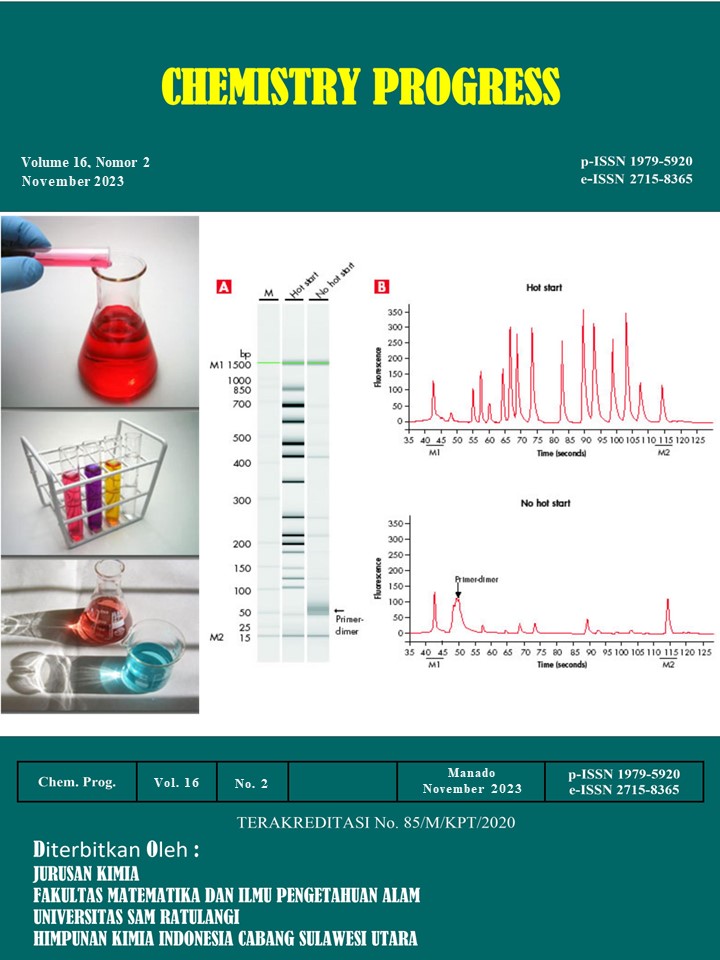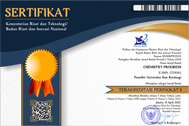Karakterisasi Serat Pangan, Penghambatan Enzim α-Amilase dan Aktivitas Antioksidan dari Daun Kubis (Brassica Oleracea L.)
DOI:
https://doi.org/10.35799/cp.16.2.2023.49222Abstract
Diabetes melitus merupakan penyakit degeneratif yang ditandai meningkatnya kadar gula darah dan gangguan metabolisme lewat mengkonsumsi makanan cepat saji (fast food). Penelitian ini bertujuan untuk menentukan kandungan hemiselulosa, selulosa dan lignin, menentukan kemampuan serat pangan sebagai penghambatan enzim α-amilase, dan menentukan fitokimia antioksidan dari daun kubis. Metodologi penelitian meliputi preparasi sampel, ekstraksi, penentuan kandungan hemiselulosa, selulosa, lignin, penentuan serat pangan, uji penghambatan enzim α-amilase secara in vitro, penentuan fitokimia antioksidan (total fenolik, total flavonoid dan total tanin terkondensasi), aktivitas penangkal radikal bebas DPPH dan radikal kation ABTS. Hasil penelitian menunjukkan bahwa tepung daun kubis yang diekstraksi dengan akuades memiliki kandungan tertinggi yaitu hemiselulosa (25,93%), selulosa (17,68%) dan lignin (15,68%). Tepung daun kubis juga menunjukkan aktivitas penghambatan pada enzim α-amilase dengan persentase tertinggi pada tepung daun kubis tanpa perlakuan (KTP) yaitu sebesar 92,12%. Pada penentuan kandungan fitokimia antioksidan terbukti bahwa ekstrak kubis etanol memiliki kandungan senyawa fenolik, flavonoid dan tanin tertinggi yang sejalan dengan aktivitas penangkal radikal bebas DPPH dan radikal kation ABTS.
Diabetes mellitus is a degenerative disease characterized by increased blood sugar levels and metabolic disorders through consuming fast food (fast food). This study aims to determine the content of hemicellulose, cellulose and lignin, determine the ability of dietary fiber to inhibit α-amylase enzymes, and determine the antioxidant phytochemicals of cabbage leaves. The research methodology included sample preparation, extraction, determination of hemicellulose, cellulose, lignin content, determination of dietary fiber, in vitro α-amylase enzyme inhibition test, determination of antioxidant phytochemicals (total phenolics, total flavonoids and total condensed tannins), free radical scavenging activity of DPPH and ABTS cation radicals. The results showed that cabbage leaf flour extracted with distilled water had the highest content, namely hemicellulose (25.93%), cellulose (17.68%) and lignin (15.68%). Cabbage leaf flour also showed inhibitory activity on the α-amylase enzyme with the highest percentage in untreated cabbage leaf flour (KTP), namely 92.12%. In determining the antioxidant phytochemical content, it was proven that the ethanol extract of cabbage had the highest content of phenolic compounds, flavonoids and tannins which were in line with the free radical scavenging activity of DPPH and ABTS cation radicals.
Downloads
Published
How to Cite
Issue
Section
License
Copyright (c) 2023 CHEMISTRY PROGRESS

This work is licensed under a Creative Commons Attribution 4.0 International License.













